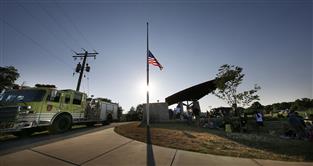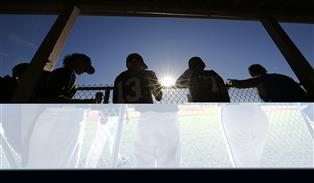Wauwatosa police, like others, are challenged and improved by technology
Her car has two video cameras, a $4,500 Toughbook laptop, a license plate reader, three GPS systems, two gun racks, a printer, a drawer in the trunk full of high-tech boxes and yards and yards of wire, and, of course, an array of roof-top lights.
She, or he, is your local police officer, and the car is a squad car, which, if you're fortunate and law-abiding, you haven't had a ride in.
The special features of the car are just the most obvious manifestations of the digital life of a police department. The Wauwatosa Police Department has 12 computer servers, a wireless network connecting police facilities and other locations and a dispatch center with 23 large screens monitoring Police and Fire department vehicle locations, crime locations and dozens of cameras throughout the department and in the community. And that isn't even all of it.
Police operations in Wauwatosa and around the country have undergone a transformation in recent decades, with law enforcement agencies relying ever more heavily on digital technology, camera surveillance and wireless communications.
The technology has increased police efficiency and officer safety, and improved the readiness of those who respond to emergencies — but it also has increased the need for IT know-how, system repair, a regular flow of technology updates and vast stores of information.
In Wauwatosa, just one person — systems administrator Michelle Dahlen — has a complete understanding of the network and all its elements. Dahlen, who also deals with the Fire Department and other city systems, said she is on call 24 hours a day, 365 days a year, and is never without her computer and her phone. Dahlen, with Sgt. Salvatore "T.J." Alioto, stands between the people and the machines.
The city Budget Committee, recognizing the growing burden of technology in the police and fire departments, has created a position in the information systems department for an employee who will work with Dahlen in the Police and Fire departments. The Common Council gets final say.
Twenty years ago
"Twenty years ago, when you got in a car, you had a radio and a shotgun, and that was it," Lt. David Moldenhauer said. "You hand-wrote your reports on triple-copy paper, and if you made a mistake or something, you either whited it out or you started over. When you were dispatched to a call, the dispatcher took the call, they called you, gave you all the information, you acknowledged, you went, they updated you as you went."
Wanted checks, license plate checks, driver's license checks, histories, descriptions, stolen vehicle checks, reports of crimes and most other information an officer needed was accessed by and relayed from the dispatch center over the radio.
"Basically, all that's done now via computer," Moldenhauer said. The officer does it, right from the computer in his squad car.
Come a long way
The department, like others, has come a long way.
"Twenty years ago there was a Polaroid camera that you would have to get from the supervisor, the shift sergeant, because film was so expensive, to go take pictures at a scene," Alioto said. Now the department has digital cameras, and, without film, pictures cost virtually nothing.
Years ago, when an officer was sent out, "they gave you a book of 20 traffic tickets, and you had to hand-write every single piece of information that went into those tickets," Moldenhauer said. If there were multiple violations, you had to write it all down again for every one.
Now, using traffic and criminal software, just entering a license plate number automatically fills in all the pertinent vehicle information. If the person driving is the owner of the car, that person's information will fill in, and, of course, adjustments are made for other drivers or new information. The only things the officer usually has to enter is the location of the violation, the violation itself and a court date. And, from a printer mounted on top of the passenger seat, it's all printed out.
Safety and time
"Not only is it more efficient this way, there's also some level of officer safety involved," Alioto said, "because every time an officer puts their head down to look at a screen or a clipboard, they're not keeping an eye on the ... vehicle."
It also shortens the length of the stop.
"If you used to write three tickets at a traffic stop, you were looking at 25 minutes," Moldenhauer said. "You can now accomplish that in six or seven."
And because the Police Department tends to deal with the same people "over and over and over again," Moldenhauer said, once a person is entered in the system, their information is automatically entered into reports when they are engaged again.
Finally, when an officer arrives back at the station, data is automatically, wirelessly, transferred to the server inside the station, Alioto said.
The Sebena example
A dramatic illustration of the power of digitization was the evidence gathered and documentation generated after the murder of police officer Jennifer Sebena.
Alioto said it filled three thick notebooks, plus audio and video files.
Instead of having a clerk spend days copying it for different agencies, he had it put on a hard drive, with color pictures, and audio and video accessible.
Technology everywhere
Fingerprinting is now digitized, removing the imprecision of ink, minimizing the effect of people who are obstructive, and eliminating the hassle of having to start all over with a set of prints when a single print is botched.
Squad cars can change stoplight frequencies when they need a green light in pursuit.
LED lights on top of cars require almost no maintenance and have reduced energy needs so much that the two heavy-duty batteries of squad cars of old have dropped to a singular regular battery.
In addition to the forward-facing video camera near the dashboard of a squad car, a wide-angle camera above the front seat keeps an eye on a person in custody in the back seat. Suspect interviews at the station of course are all videotaped.
And video technology below the lights on the roof of a squad car recognizes and captures license plate numbers on cars ahead, sending an alert to the officer when a stolen or criminally involved car is recognized.
And, finally, the phone system is digitized.
Keeping track
It's all a lot to keep track of.
Dahlen said she spends a lot of time "putting out fires."
"It's just never-ending, and there's so much of it, and many days you get nothing done but that," she said.
She pointed outside her office window to a car awaiting configuration of a new camera. She said while she could do the job by remote access through her computer, it's easier and faster just to go out to the car and do it there. She said she works on cars "all the time. Daily."
She gets help keeping up with things from Alioto, an administrative sergeant with a knack for computers. His real responsibility is not tech support but bigger-picture integration, planning and training. As a sworn officer, his value is better used in understanding what would help the officers in the field, and what would be of less value, among all the things available.
For example, Alioto is interested in how tablets might help detectives and officers when they interview citizens in their homes.
Dahlen said her highest priority was keeping in step with federal standards on security.
While Dahlen has a lot on her plate, it does allow her to see ways in which city systems can be made more efficient. One example is an initiative by the city's Water Utility to put a video surveillance system on water facilities, for which the city received an $80,000 homeland security grant.
By integrating the water facilities with the Police Department's existing surveillance system through a new wireless communications network, the city saved money over the leased lines it was using, which cost a monthly fee. The project won an "Effective Use of Technology Award" from the Public Policy Forum.
Dahlen spent a decade with the city of Racine in a similar job, before taking her current job 11 years ago. She said she's not irreplacible — between vendors and officers like Alioto, the city could do what it needs to do. But she welcomes the help offered by the city.
More from News and Features
- Anodyne Coffee plans to open location in Wauwatosa Village
- Wauwatosa Meetings: Aug. 4
- Video: Wauwatosa girl's curbside ice cream stand raises money for the hungry
- Wauwatosa News and Notes: Hands-only CPR training offered; Firefly Art Fair is Aug. 6-7
- Wauwatosa Ask Now: Why are there barriers and fencing along the North Avenue bridges over the Menomonee River?
- Mystery Photo Contest: July 28
- Wauwatosa gears up for National Night Out event, this year at the zoo
- Election 2016: Wisconsin's 4th District candidates weigh in
- Wauwatosa's Luther Manor residents share smiles through flower delivery
- Wauwatosa Police Report: July 17-23















